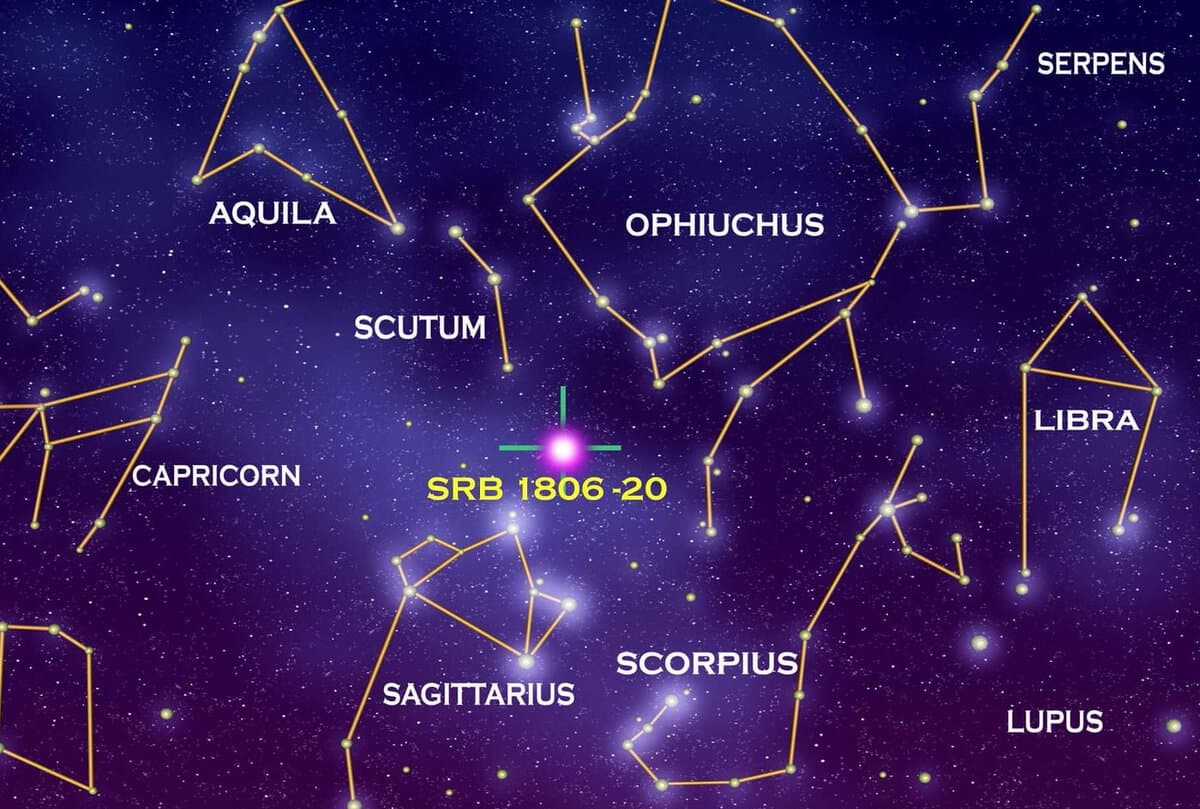The zodiacal constellations are unique in that they are the only constellations where the Sun, Moon, and planets can be found. Although there is no other distinction, this is enough to attribute special properties to them. In astrology, all horoscopes are based on the 12 zodiac signs – constellations, even though there are actually 13.
Zodiacal constellations have held significance since ancient Greece. The modern boundaries of all constellations, including the zodiacal ones, were established in 1928 by the International Astronomical Union. These boundaries have no relation to those accepted in astrology – in astrology, the entire circumference of the ecliptic is divided into 12 equal parts, while in astronomy there are 13 zodiacal constellations, each with different sizes.
What constellations belong to the zodiac and why
There are thirteen constellations that are zodiacal: Aries, Taurus, Gemini, Cancer, Leo, Virgo, Libra, Scorpio, Sagittarius, Capricorn, Aquarius, and Pisces. In astrology, only twelve of these constellations are considered to be part of the zodiac, with the Serpentine being excluded from the list.
The reason why these thirteen constellations are significant is quite simple – they lie along the ecliptic, which is the path of the Earth’s orbit around the Sun. As the Earth completes its orbit over the course of a year, the Sun appears to move along the ecliptic line, passing through different constellations in the background.
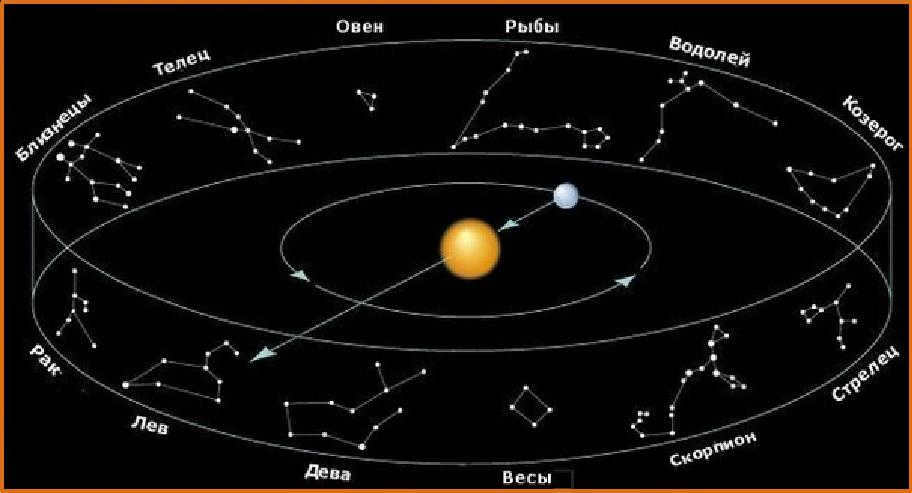
The position of the zodiacal constellations changes as the Earth completes its orbit around the Sun.
For instance, towards the end of May, we observe the Sun in alignment with the Taurus constellation, while towards the end of September, it aligns with Virgo. However, due to the Sun’s brightness, we are unable to see these constellations during the daytime. Conversely, the constellations that were visible six months ago are now positioned on the opposite side of the Earth and are best observed during the nighttime.
Consequently, the Sun is situated in the Sagittarius constellation from December 18 to January 19, rendering it invisible in the sky. However, it will be in optimal viewing conditions six months later, during June and July.


A star chart displays the path of the Sun, Moon, and planets throughout the year by indicating the ecliptic line. This line intersects with the zodiacal constellations.
Throughout the course of a year, the Sun traverses all the zodiacal constellations, returning to its starting point as the Earth completes a full orbit. In a span of a month, the Moon also visits all of these constellations as it completes a full revolution around the Earth in 27 days. The planets, too, reside within these constellations, but their movement through them varies based on their distance from the Sun and Earth. Their position in the sky is influenced by the Earth’s motion around the Sun and the planets’ own motion within their orbits.
A comprehensive list of zodiac constellations
Here is an extensive list of zodiac constellations in their respective order, along with the period when the Sun is present in each.
The brightest stars within zodiac constellations
Within the zodiac constellations, only seven constellations contain the fifteen brightest stars. All other stars have relatively average brightness and do not stand out compared to many others.
- Aldebaran (α Taurus) – 0.85m
- Antares (α Scorpio) – 0.96m
- Spica (α Virgo) – 0.98m
- Pollux (β Gemini) – 1.14m
- Regulus (α Leo) – 1.35m
- Castor (α Gemini) – 1.57m
- Shaula (λ Scorpio) – 1.63m
- El-Nat (β Taurus) – 1.65m
- Kaus Australis (ε Sagittarius) – 1.79m
- Sargas (θ Scorpio) – 1.86m
- Alchena (γ Gemini) – 1.93m
- Hamal (α Aries) – 1.98m
- Algieba (γ Leo) – 1.98m
- Nunki (σ Sagittarius) – 2.05m
- Denebola (β Leo) – 2.14m
Zodiacal constellations in astrology
The zodiacal constellations in astrology should not be mistaken for their astronomical counterparts. While in astronomy they are confined within their complex and irregular boundaries, astrology presents a different perspective.
Astrological zodiacal constellations are purely conventional – the entire circumference of the ecliptic is divided into 30-degree arcs, resulting in 360 degrees over 12 months. Each arc corresponds to one of the twelve zodiacal constellations, with Serpens being excluded from this list. Thus, in astrology, each month corresponds to one of the astrological signs.
It should be noted that all of this is purely conventional and bears no relation to the actual state of affairs. Take astronomy, for instance, where we can observe that the Sun only spends 7 days in the constellation of Scorpio, while in astrology it is associated with an entire month.
As a result, the zodiac signs used in astrology have very little in common with the actual zodiacal constellations, aside from their names. Furthermore, the astrological symbols for these constellations are not recognized in the field of science.
Thousands of years ago, the zodiacal constellations served as a calendar, with each one representing approximately one month from beginning to end. However, due to the vernal equinox point shifting by 1 degree every 70 years, there is now some confusion in the classification of star formations.
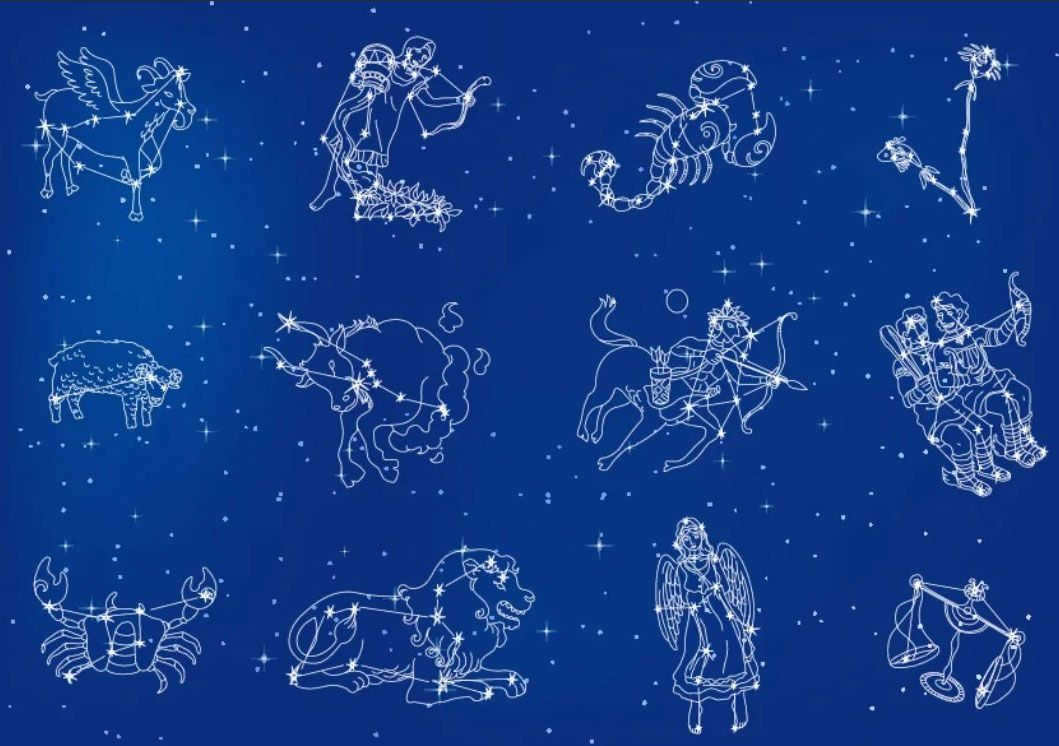
The group of constellations that the Sun appears to pass through over the course of a year are known as zodiacal constellations. This term is often used to refer to the twelve constellations that lie along the Sun’s apparent annual path. They are commonly referred to as the zodiac signs. These constellations are easily visible from Earth and can be seen in relation to other celestial bodies. They are located along the ecliptic, which is the path the Sun takes through the sky as observed from our planet. The zodiacal constellations are significant in astrology and have been studied for centuries.
List of constellations in sequential order
The arrangement of zodiac signs is as follows.
Aries
In ancient Greece, the zodiacal year used to commence on March 20, the day of the vernal equinox, and this phenomenon will repeat after 24,000 years. However, in the present day, the Sun initiates its journey through the first constellation in this series – Aries – on April 19 and concludes on May 13. There are numerous stars in this region of the sky, but only Hamal (Gamal), Sheratan (Sharatran), and Mezartim are visible to the naked eye.
According to mythology, this constellation was the winged ram Crius, who was elevated to the heavens by the cloud goddess Nephela to safeguard her children. Crius successfully completed the mission by carrying the twins Gella and Phrixus to Colchis.
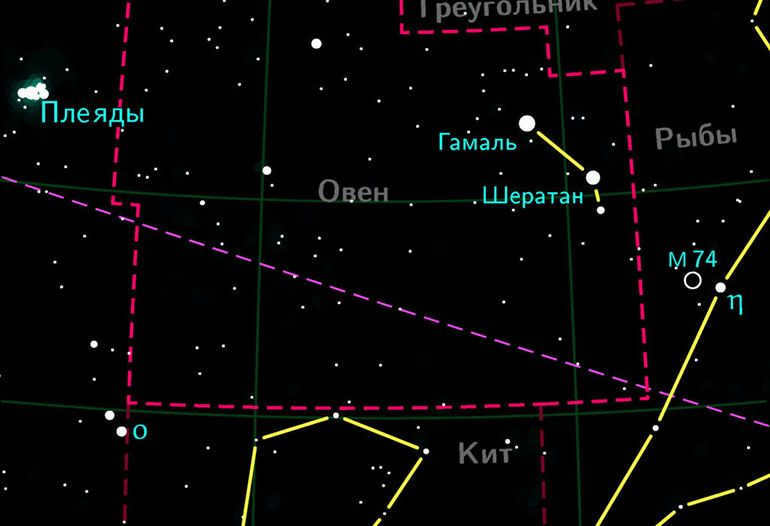
Taurus
Taurus is the second sign in the zodiacal circle, with the Sun entering it on May 14th. It is a vast constellation consisting of over a hundred objects that can be seen without the need for astronomical equipment. Among them, 14 are the brightest. In this part of the sky, you can also find the Pleiades and Hyades, which are scattered star clusters. The Pleiades are a compact group of bright stars located in a relatively empty area of the sky, while the Hyades, along with Aldebaran (the alpha star of Taurus), form a shape resembling the Latin letter V.
There are three versions that explain the identity of Taurus in the night sky:
- Zeus, who transformed into a white bull and abducted Europa, taking her to Crete;
- The Cretan bull that was defeated by Hercules;
- The fierce, fire-breathing bull that was tamed by Jason in Colchis.
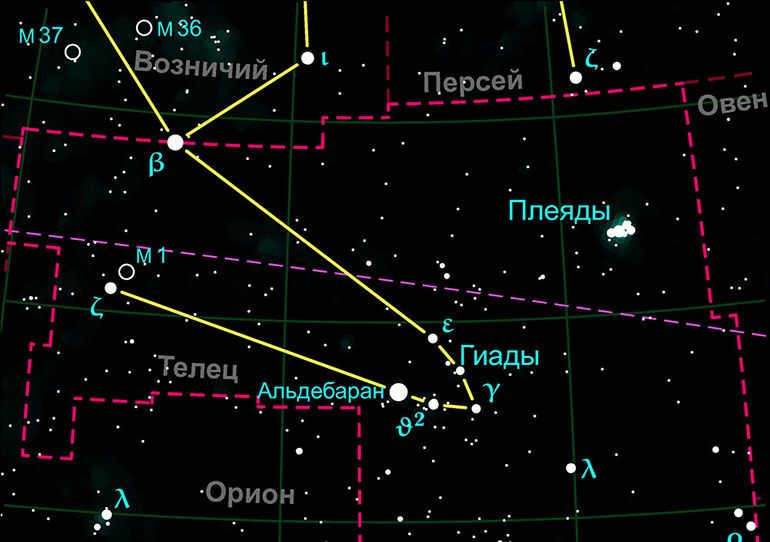
Gemini
Starting from June 20th, the Sun moves into the Gemini constellation, which is made up of approximately 70 stars. Among them, the most prominent ones are Castor and Pollux, named after the twins Dioscurus, who ascended to the sky as a representation of genuine sibling affection.
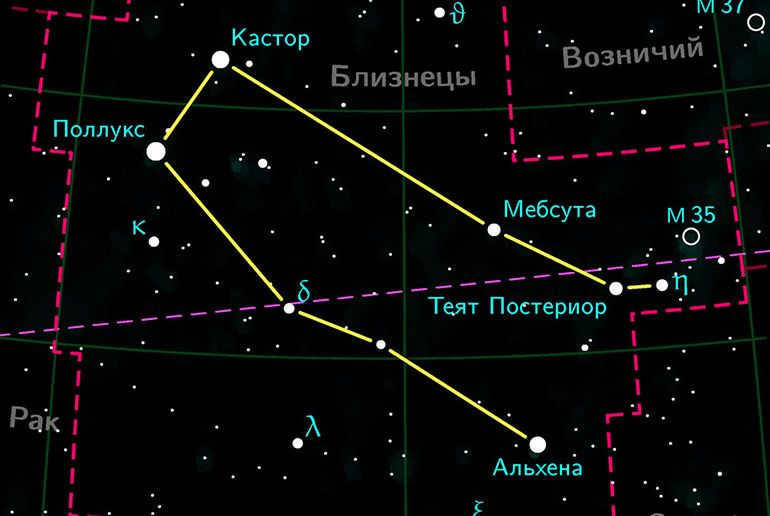
The Crab
On July 21, the Sun begins its journey through the constellation of Cancer, which is the least prominent among the zodiacal constellations and can only be easily observed on a clear night. Within this constellation, there are approximately 60 visible celestial objects that can be seen with the naked eye, with the brightest one being Altarf.
Two millennia ago, the zodiac sign associated with the summer solstice was occupied by this particular constellation. It was given the name in commemoration of the arthropod vanquished by Hercules. Amidst the battle between the hero and the Lernaeus hydra, only this creature from the animal kingdom refused to aid the giant, instead biting his leg, resulting in its instant demise. As a gesture of gratitude, the goddess Hera, who despised Heracles, sent the crayfish (or possibly a crab) as a constellation of stars in the sky.
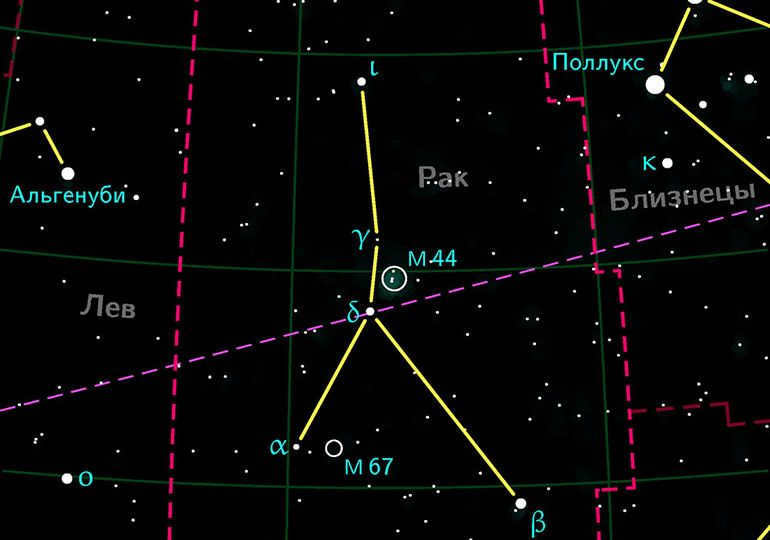
Leo
From August 10th to September 15th, the sun can be found in the Leo constellation, which is the most brilliant among all the constellations in the zodiac. The brightest star in Leo is Regulus, followed by Algieba and Denebola. According to mythology, this constellation is associated with the Nemean lion, which was defeated by Hercules. One interesting feature of Leo is the presence of several asterisms:
- The Sickle, located on the right side of the constellation, resembles a mirror image of a question mark with Regulus at its lowest point;
- The Tassel, which has been recognized as a separate constellation called the Hair of Veronica since 1536;
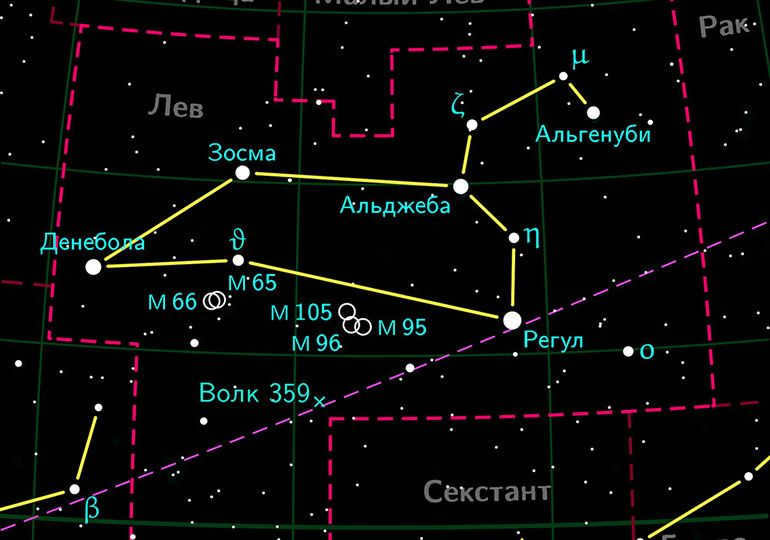
- the location of the winter solstice;
- the central point of our galaxy (approximately 30,000 light-years away), which is partially obscured by interstellar dust clouds;
- the most breathtaking segment of the Milky Way;
- a multitude of star clusters, dwarf galaxies, and nebulae;
- more than 5,500 variable stars;
- two recognizable constellations – the Teapot and Terebellum (cross-shaped formations).
- Ganymede, the divine cupbearer of the Olympians;
- Kekrop, the ancient king of Attica;
- Deucalion, the hero who survived the Great Flood.
- The 14th brightest star in the nighttime sky, alpha Aldebaran of Taurus;
- The 15th brightest star in the nighttime sky, Alpha Antares of Scorpio;
- Number 16, alpha Spica of Virgo;
- Number 17, beta Pollux of Gemini;
- Star number 21, alpha Regulus of Leo;
- Ranked #23 on the list of the brightest entities, alpha Castor of Gemini.
- Aldebaran (α Taurus) – 0.85 m
- Antares (α Scorpius) – 0.96 m
- Spica (α Virgo) – 0.98 m
- Pollux (β Gemini) – 1.14 m
- Regulus (α Leo) – 1.35 m
- Castor (α Gemini) – 1.57 m
- Shaula (λ of Scorpio) – 1.63 m
- Kaus Australis (ε Sagittarius) – 1.79 m
- Sargas (θ Scorpio) – 1.86 m
- Hamal (α Aries) – 1.98 meters tall
- Algieba (γ Leo) – 1.98 meters tall
- The constellations of the zodiac (derived from the Greek word ζωδιακός, meaning “animal”) consist of 13 constellations positioned along the ecliptic, which is the annual path of the Sun among the stars that is visible to us. These constellations are named after animals, a tradition that dates back to ancient times.
The Leonids meteor shower, which occurs in this part of the sky, reaches its peak every 33 years in November.
Virgo
In the constellation Virgo (which has nearly 160 objects visible to the naked eye) the Sun enters on September 16, marking the modern point of the autumnal equinox. This formation has various possible namesakes, including Erigone, Demeter, Gaia, or Rhea. Additionally, the star Vindemiatrix, also known as the gamma of Virgo, is associated with Dionysus and represents the young boy Ampelus who was transformed into a star.
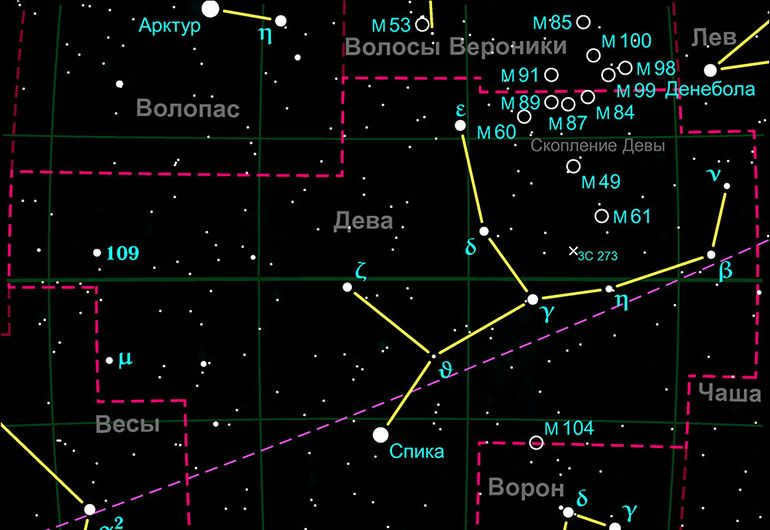
Libra
The Libra constellation used to be a part of the neighboring Scorpio, but eventually moved away. Its origin is attributed to the actions of Astrea, the daughter of Zeus, who would wander the earth with scales in her hands to judge the good and bad deeds of people. This constellation is made up of nearly a hundred stars, with the brightest ones forming a rectangular shape.
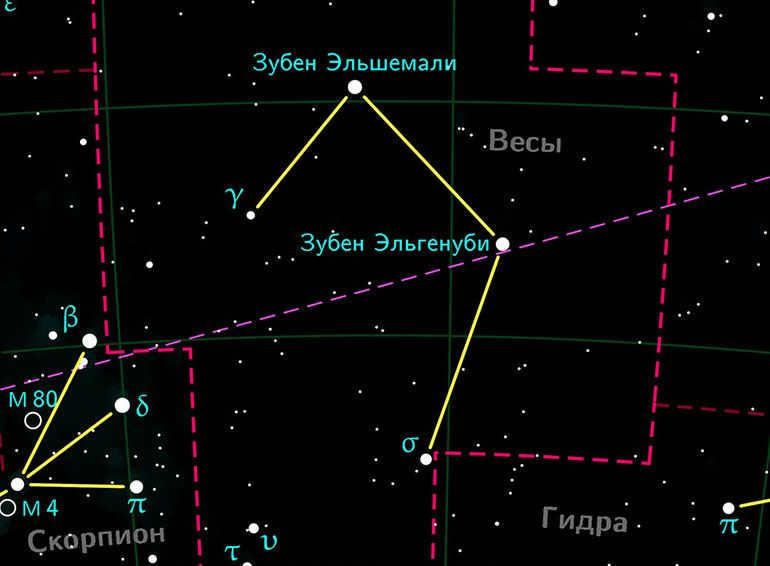
Scorpio
From October 31 to November 22, the Sun moves through the Libra section of the sky, and on the following day, it enters the Scorpio constellation, remaining there for 6 days before moving on. This constellation represents the creature that was tasked by Artemis to kill Orion out of anger. There is a captivating myth that these two constellations cannot coexist in the sky simultaneously – when Scorpio rises in the east, Orion hides behind the western horizon.
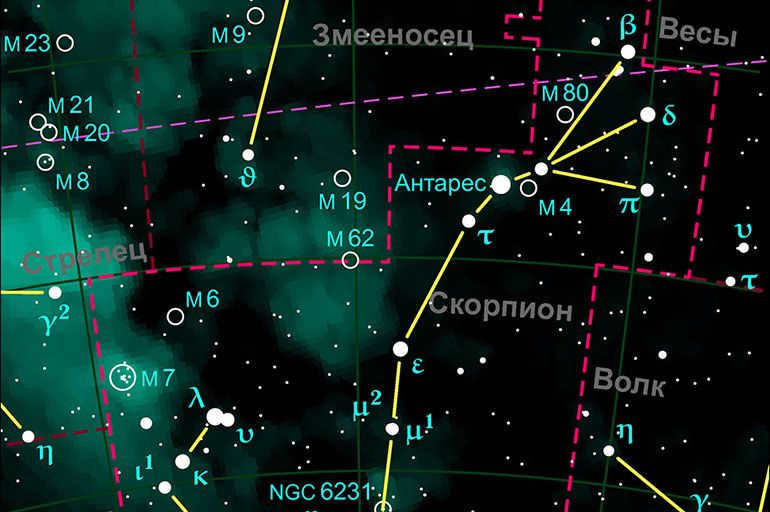
The Serpentine
Starting on November 29, the Sun begins its journey through the constellation known as The Serpentine. This particular constellation is unique in that it is not included in the traditional zodiac. According to Greek mythology, The Serpentine is associated with Asclepius, the god of healing, who was sent to the heavens by Zeus for his audacious act of resurrecting the dead. The stars that used to be part of this constellation have now been separated and are now recognized as a separate entity known as The Serpent.
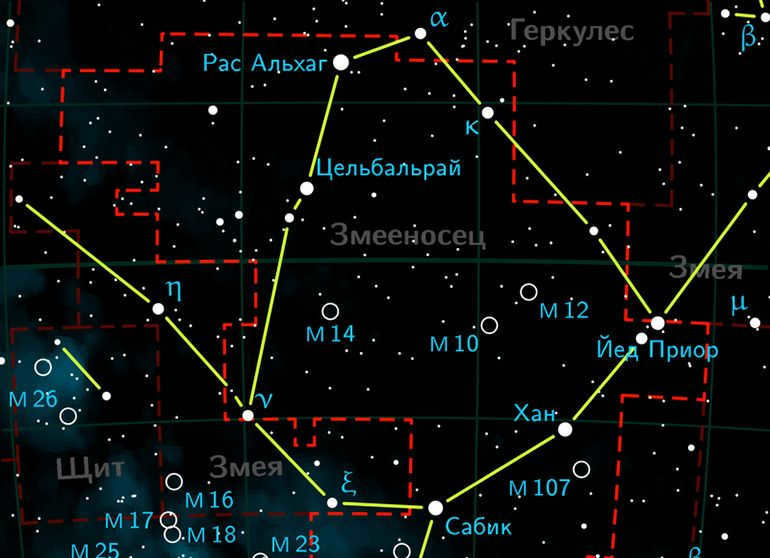
Sagittarius
Following the Serpent, our sun moves into the constellation of Sagittarius, which occurs between December 18 and January 18. Sagittarius is an extraordinary star cluster for various reasons. It encompasses:
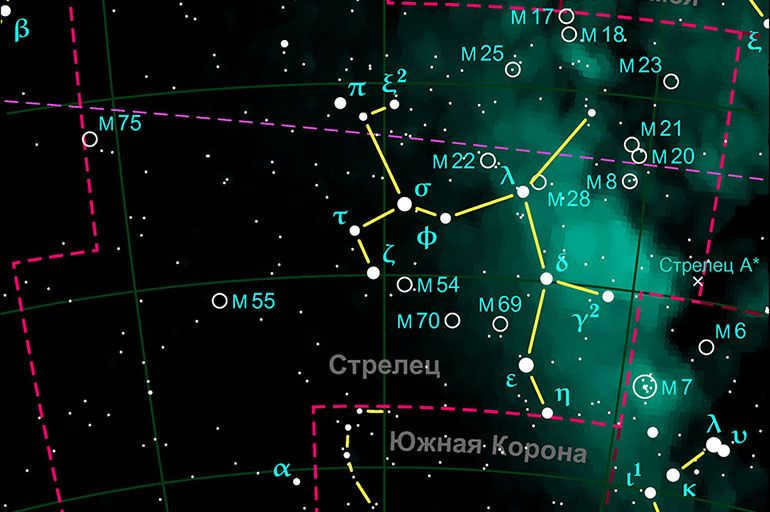
Sagittarius in mythology is represented by either the centaur Chiron or Krotos. Chiron, the first one, created the celestial globe specifically for the Argonauts. He even reserved a spot for his own constellation.
Another legend states that the empty space was claimed by Krotos, the genius behind inventions like applause and archery. Chiron, on the other hand, became Centaurus in the night sky.
The period from January 19 to February 15 is when the Sun is positioned in the zodiac sign of Capricorn. The constellation representing Capricorn is depicted as a mythical creature, often described as either a goat or a fish. According to mythology, it is believed that Capricorn may have been the son of Hermes, the messenger god, who transformed into a goat with a fish tail after diving into the sea as a man. This extraordinary transformation caught the attention of the gods, who then elevated Capricorn to the heavens, amazed by the creation of such a unique and fantastical being.
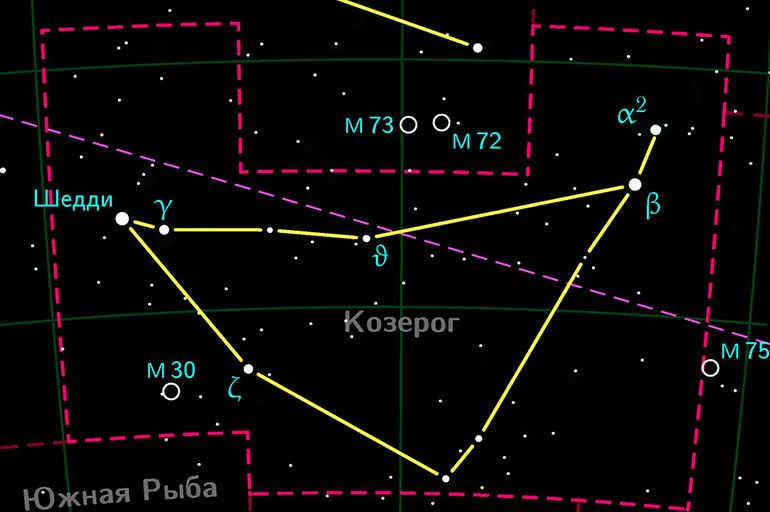
Aquarius
Aquarius is a vast assemblage of celestial bodies, encompassing 9 entities with a stellar magnitude lower than 4. This constellation is entered by our celestial body on February 16. It portrays various figures from ancient mythology:
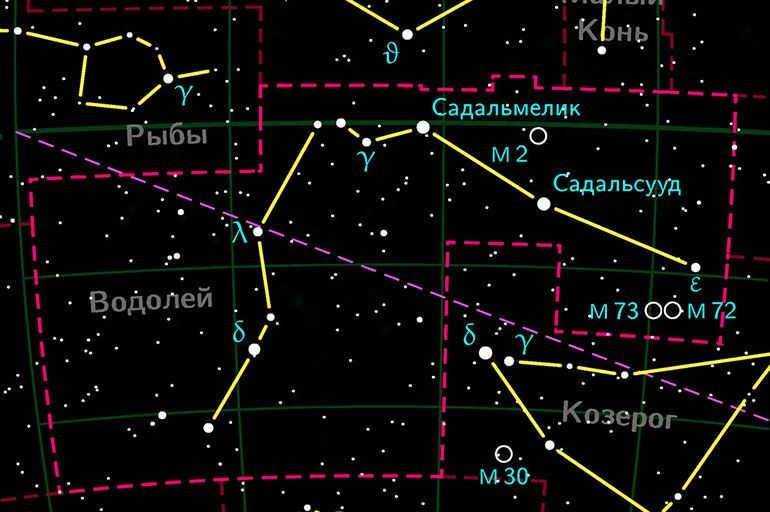
Pisces
The constellation of Pisces marks the end of the Sun’s journey, occurring from March 12 to April 18. Pisces is a significant constellation representing the mythological tale of Galatea and Akida, two lovers who were chased by the Cyclops Polyphemus, who was infatuated with Galatea. Refusing to be separated, they chose to jump into the sea, and the gods then immortalized them in the stars above.
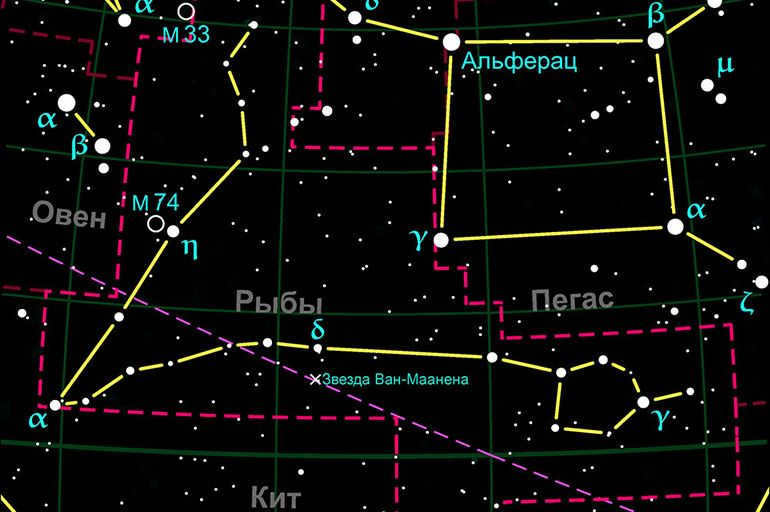
The most brilliant stars
Among the celestial bodies of the initial stellar magnitude, the zodiacal constellations contain:
Although the last star in its constellation is the largest, it is not the brightest. Pollux outshines it in terms of brightness. This is because when ranking stars in the same constellation based on brightness, priority is given to those that are located to the north.
Visual representation of zodiacal constellations
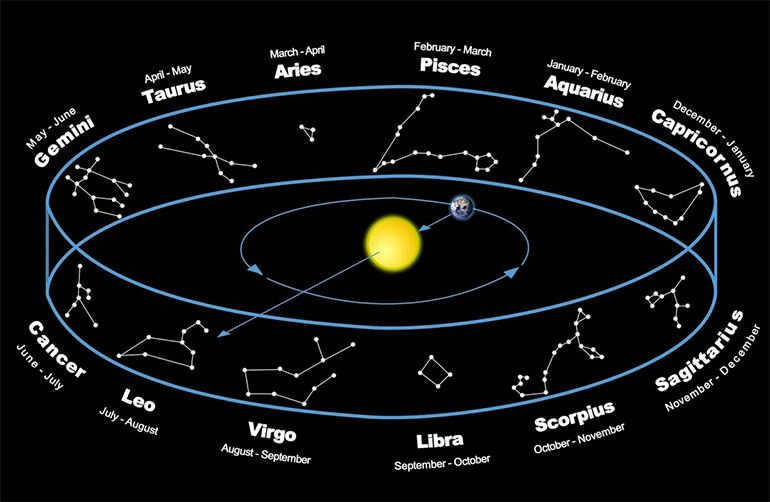
The ancient Greek scientist Eudoxus of Cnidus is believed to have created the original chart of the zodiacal constellations. With the help of modern technology, more detailed maps of these celestial areas can now be produced.
Fascinating information
Several stars within the zodiacal circle have their own satellite planets. One example is Gliese-581, a red dwarf located in the Libra constellation, which possesses its own planetary system. Three of these objects are potentially capable of supporting and nurturing life.
Ancient astronomers were the ones who identified the zodiacal constellations. They were the first to notice that certain stars in the sky form groups. These constellations were named after animals due to their resemblance to their outlines, and these names have been passed down to us today.
Although it may be difficult for us to understand why these figures are named Capricorn or Leo, it is important to consider that the map of the starry sky has changed slightly over time. However, the influence of zodiacal constellations on those born during their “reign” has remained constant. How do they impact us and our choices in life?
What are the zodiac constellations?
Which constellations are referred to as zodiac constellations? These constellations are located in different parts of the sky, evenly divided into thirty-degree sections in terms of longitude. There are two types of zodiac constellations: tropical and sidereal (“stellar”).
The beginning of the tropical zodiac is the day of the vernal equinox, while the sidereal zodiac defines the zodiac signs based on their images of zodiacal constellations. In this article, we will provide a brief overview of the zodiac constellations, teach how to accurately identify them, and introduce their main characteristics.

It’s important to keep in mind that the zodiacal constellations encompass not only the planets, but also the Moon and the Sun. While the planetary trajectory may vary, the Sun’s path remains constant. The Sun moves along the ecliptic, a line relative to the other stars as observed from Earth. The zodiacal constellations are situated along the ecliptic plane. The zero degree of Aries, known as the vernal equinox, serves as the starting point for this trajectory.
What is the total number of zodiacal constellations? There are twelve of them, and they are situated in the respective regions of the ecliptic, which are measured from the Vernal Equinox Point. This is how the twelve signs of the Zodiac were formed. Since the ecliptic, like any other circle, measures 360 degrees, each sign covers an area of 30 degrees.
Among the zodiacal constellations, there are numerous stunning stars. We will provide a list of the twelve brightest ones, along with their apparent stellar magnitude:
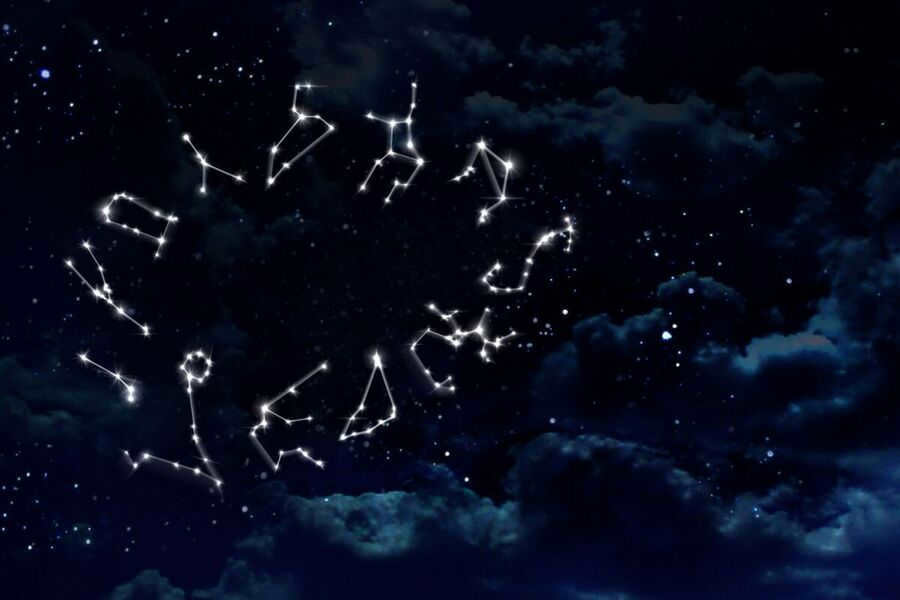
Characteristics of the 12 zodiacal constellations
In ancient times, the names of the signs of the Zodiac were derived from the zodiacal constellations that they closely aligned with.
The zodiacal constellations vary depending on the seasons. This means that the Sun enters the signs at different times each month. Why does this occur? The reason is that the average length of Earth’s rotation, which is 365.256366 days, differs from the calendar year (365 days with a leap year adjustment).
This cycle occurs approximately every four years. This is the reason why individuals who were born on the cusp of signs and are unsure of their exact birth date cannot definitively determine which Zodiac sign they belong to.
The history of the constellations of the Zodiac spans thousands of years. Animal symbols were first introduced by Ancient Greek astronomers. Each Zodiac sign has its own distinct legend. Let’s delve into some examples of Zodiac constellations in greater detail.
Aries (March 21 – April 19).
When it comes to the sequence of zodiac constellations, it is always important to begin with Aries – its zero degree serves as the focal point for the path of the ecliptic.
Aries is characterized as a masculine, daytime zodiac sign that is cardinal, equinoctial, and oriental. It is naturally fiery, hot, and dry, exhibiting traits of being choleric, animalistic, immoderate, and violent.
Brave warriors are born under the zodiac sign of Aries, known for their strong sense of justice and dedication to upholding it. Aries individuals are typically optimistic and stubborn. They dislike repetitive tasks and find it difficult to stay in one place for long, often becoming fatigued and losing interest. This pattern also extends to their personal relationships. Aries people are passionate and fiery, but their love and passion tend to burn out quickly, leading them to frequently change their romantic partners.
Taurus is a feminine, nocturnal, earthy, cold, dry, phlegmatic, fixed, animal or animal sign, the southern, nocturnal house of Venus.
Taurus possesses a strong desire to make the world a better place. They not only enjoy doing it ─ they excel at it. Even when faced with seemingly insurmountable obstacles, Taurus is able to turn them into triumphs. Individuals born under this sign radiate positivity and have a knack for uplifting others. They treat their loved ones with kindness and care, and woe betide anyone who dares to insult someone dear to Taurus ─ they can quickly transform into a raging bull.


Gemini (May 21-June 20)
Gemini is an airy, hot, and humid zodiac sign that is associated with the northern hemisphere. It is considered a masculine and daytime sign, and it is ruled by Mercury. Gemini is known for its dual nature and unpredictable behavior. People born under this sign can go from being joyful and fun-loving one day to melancholic the next. They dislike routine and often have artistic talents. Even if they don’t make it to the theater stage, they will still bring their creative energy to everyday life.
Cancer (June 21-July 22)
The astrological sign of Cancer is associated with feminine energy, as well as nocturnal qualities. It is linked to the element of water, which gives it a sense of fluidity and emotion. Cancer is considered a cold and wet sign, which can contribute to its melancholic nature. This sign is also known for being cardinal, meaning it is a leader and initiator in the zodiac.
One unique aspect of Cancer is that it is associated with the summer solstice, the longest day of the year. This further emphasizes its connection to the sun and warmth. Cancer is often described as a silent and slow speaker, taking their time to carefully choose their words.
Cancer is seen as a fertile sign, symbolizing growth and abundance. It is associated with the northern hemisphere, which adds a sense of stability and groundedness. The Moon is the ruling planet of Cancer, and this sign is the only house of the Moon in the zodiac.
People born under the sign of Cancer tend to experience personal dramas and intense emotions. These feelings can consume them, causing them to become absorbed in their own world. They may prioritize their family and loved ones above all else, often worrying about their well-being more than their own. Despite their focus on emotional matters, Cancerians do not necessarily have anything against material wealth and luxury goods.
Leo (July 23 – August 22)
Leo is represented by the masculine energy and is associated with daytime, fire, heat, dryness, and a choleric temperament. It is a commanding and animalistic sign, often seen as barren and having an oriental influence. Leo is ruled by the Sun, making it the only house that the Sun occupies.
Throughout history, lions have always captivated attention and refused to fade into the background. People born under the sign of Leo have a refined taste and a keen sense of beauty. They have a love for luxury and make no effort to hide it. These individuals are often either adored or disliked, but they never go unnoticed. However, it is important to remember that beneath their bold exterior, Leos possess a delicate and vulnerable nature.
Virgo (August 23 – September 23)
Virgo is characterized as feminine and nocturnal, representing the earth element. It is associated with qualities such as coldness, dryness, and phlegmatic temperament. As a mutable sign, Virgo is adaptable and open to change. It is considered a human sign, reflecting its focus on practicality and service. Virgo is also associated with the southern direction.
Mercury rules Virgo and is considered to be its domicile and place of exaltation. Some believe that Virgo is the zodiac sign that attracts the most intelligent individuals. This intelligence extends beyond traditional intellect and includes emotional intelligence as well. Virgos have a knack for controlling their emotions and maintaining a level-headed approach. They excel at forming strong, long-lasting relationships but also find contentment in solitude, as they have a deep understanding of self-harmony.

Libra (September 24 – October 22)
Libra is a masculine sign that is associated with daytime, heat, humidity, sanguine temperament, cardinal mode, human nature, the autumn equinox, and the western direction. It is also known as the daytime house of Venus.
There is a common misconception that Libra is indecisive. However, this is not entirely true. Libra simply takes more time than others to make a decision. Individuals born under this zodiac sign thoroughly analyze all aspects of a situation, paying close attention to details and carefully weighing the pros and cons.
Libra is known for being friendly and sociable, effortlessly winning the favor of others with their impeccable manners. People with this sign find it challenging to reveal their true emotions and thoughts.
Scorpio (October 23 – November 22)
Scorpio is characterized by femininity, nocturnality, an affinity for water, coldness, moisture, melancholy, a northern orientation, and a fixed nature. It is also known as the night house of Mars.

Individuals born under the Scorpio zodiac sign possess a complex nature that effortlessly captivates the attention of others. If a Scorpio chooses to do so, they will support any individual without any ulterior motives. The personal lives of Scorpios are consistently filled with passion and intense emotions, which suits them perfectly. Scorpios have a dislike for and lack the ability to be alone, readily and willingly forming relationships with new partners.
Sagittarius (November 23 – December 21)
The sign of Sagittarius is characterized as masculine, diurnal, fiery, hot, dry, choleric, mutable, double-bodied, and oriental. It is ruled by the planet Jupiter and corresponds to the ninth house in astrology.
Sagittarius individuals are known for their adventurous and risk-taking nature. Unfortunately, this inclination towards excitement often leads them into unpleasant or even dangerous situations. However, Sagittarians are not deterred by failure or obstacles; in fact, they find them to be motivating factors that ignite their interest. Their fearless attitude and optimistic outlook attract people towards them, resulting in strong friendships and romantic relationships. It is not uncommon for those born under this sign to have a loyal following of admirers who are willing to go to great lengths to support and protect them.
Capricorn is characterized as being feminine, nocturnal, grounded, chilly, dry, phlegmatic, and quadrupedal. It is ruled by Saturn and is the exaltation sign of Mars.
Capricorns consistently achieve success and rightfully so: they possess the knowledge and passion for hard work, have a sensible assessment of situations and their own abilities. These qualities enable Capricorns to overcome significant obstacles and accomplish ambitious goals. Individuals born under this sign do not view the world through rose-colored glasses; they are accustomed to achieving everything on their own. However, the pragmatism of Capricorns can sometimes lead to unwarranted pessimism.


Aquarius (January 20 – February 18)
Aquarius is described as being masculine, having a daytime orientation, being of hot and humid nature, sanguine temperament, belonging to the fixed modality, having human qualities, being rational and associated with the Western direction. It is ruled by Saturn and is located in the second house of the zodiac.
Individuals born under the Aquarius sign are known for their self-sufficiency and their pursuit of independence. Despite being surrounded by loved ones, they may not always feel truly understood by them. Aquarians possess a remarkable ability to uncover the truth in any situation, even the most perplexing ones. They also possess unconventional thinking and excellent intuition.
Pisces (February 19 – March 20)
Pisces is a feminine zodiac sign that is diurnal, cold, damp, melancholic, mutable, bipedal, and northern. It is ruled by Jupiter and is the place of Venus’ exaltation.
Pisces is well-known for its romantic nature, which, when combined with melancholy, gives its character an air of mystery and allure. This sign lacks energy and resilience, often preferring to take a backseat in challenging situations. However, this weakness is easily forgiven due to the kind and sweet nature of those born under this sign. They have a soft communication style, which makes it effortless to form close and warm relationships.
Zodiacal constellations have been the subject of study in astrology for many years, and their history is filled with numerous myths and enigmas.
How the Sun moves across the zodiac constellations
The zodiac signs can be determined in two ways. The first method involves calculating them using a table based on the dates of the civil calendar. The second method involves determining the signs based on the Sun’s position on the ecliptic. It’s important to note that the durations of the Sun’s passage through the zodiac constellations vary greatly.
For instance, the period for the Sun to pass through Virgo is 45 days, while it only takes 20 days for it to move through Cancer and just 7 days for Scorpio. Below is a concise table summarizing the calculation of zodiac constellations.
| Sign | Period in astrology | Astronomy data |
| Aries | March 21 – April 20 | April 19 – May 13 |
| Taurus | April 21 – May 21 | May 14 – June 19 |
| Gemini | May 22 – June 21 | June 20 – July 20 |
| Cancer | June 22 – July 22 | July 21 – August 9 |
| Leo | July 23 – August 21 | August 10 – September 15 |
| Virgo | August 22 – September 23 | September 16 – October 30 |
| Libra | September 24 – October 23 | October 31 – November 22 |
| Scorpio | October 24 – November 22 | November 23 – November 29 |
| Sagittarius | November 23 – December 22 | December 18 – January 18 |
| Capricorn | December 23 – January 20 | January 19 – February 15 |
| Aquarius | January 21 – February 19 | February 16 – March 11 |
| Pisces | February 20 – March 20 | March 12 – April 18 |
There are a total of twelve constellations in the list of zodiac signs. However, what many people are not aware of is the existence of a thirteenth sign called Serpentine.
The Reason Behind the Inclusion of 13 Zodiac Constellations in Astrology
Serpentine, the thirteenth sign of the Zodiac, is positioned between November 29 and December 17. As a result, according to the commonly used calculation table, Sagittarius falls within this time frame.
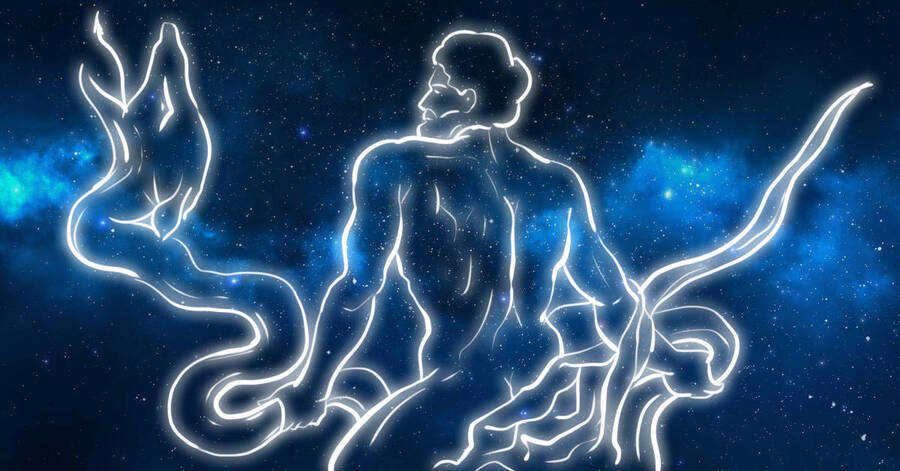

The inclusion of the Serpent constellation, situated between Scorpio and Sagittarius, resulted in a complete shift of dates and a major reorganization of the zodiac constellations in the celestial sphere. This has left many individuals feeling disappointed, as they discover that their astrological sign has changed. For instance, with the inclusion of the Serpent, November now accommodates three zodiac signs ─ Libra, Scorpio, and Sagittarius.
Why is the Serpentine zodiac constellation considered to be one of a kind? The reason behind this is that it is the only sign that was based on a real individual. This sign is associated with Imhotep, who lived in Ancient Egypt during the 27th century BC. According to historical records, Imhotep was responsible for introducing the healing arts to human civilization.
The Serpentine constellation is part of the zodiac constellations that are visible during the summer season. It is most easily observed during this time of the year.
Individuals born under the Serpentine sign always choose not to retaliate with evil. However, their lives are marked by a constant dichotomy of light and darkness, happiness and sorrow, and ups and downs. It is challenging to summarize the characteristics of the thirteenth sign in just a few words. Individuals born under this sign have complex personalities themselves.

The Serpentine has the ability to swiftly demolish everything that took years to build, clinging to insignificant things. These individuals are unpredictable and inconsistent, often plagued by destructive habits such as alcohol or smoking.
On the starry sky map, the zodiac constellations form intricate patterns, while the stars themselves don’t create any specific shapes in the vast expanse of space. It’s important to note that the distance between Earth and individual stars changes over time, sometimes by several tens of light years.
We can only see photographs of the night sky with our naked eye because we can only perceive two dimensions of the celestial sphere, without accounting for depth. However, there’s no denying that the zodiac constellations serve as crucial landmarks in the history of human civilization.
Related concepts
Scorpio (Latin: Scorpius) is a constellation in the southern hemisphere that is situated between Sagittarius to the east and Libra to the west. It is entirely located within the Milky Way and is bordered by Serpens to the north and Sacristan to the south.
The Eagle (Latin: Aquila) is an equatorial constellation. Its western portion is situated in the eastern branch of the Milky Way, south of the Arrow constellation. The total area of the Eagle constellation is 652.5 square degrees, and it contains a total of 70 stars that are brighter than magnitude 6.
Ara (also known as Latin Ara) is a constellation located in the southern hemisphere of the sky. It covers an area of 237.0 square degrees and contains 60 stars that can be seen with the naked eye. In the southern region of Russia, below latitude 44° 30′, a small portion of the constellation can be observed rising very close to the horizon during the months of May and June. However, this part does not have any prominent stars. The star α Sacristan, which has a magnitude of 2.95, cannot be seen in Russia. However, under favorable conditions, it can be visible near the horizon line in southern cities of the post-Soviet region below latitude 40° 08′, such as Bukhara, Samarkand, and Nakhichevan.
Constellations are divisions of the celestial sphere used in modern astronomy to facilitate navigation and orientation in the night sky. In ancient times, constellations were referred to as distinctive patterns created by bright stars.
Taurus is a constellation of the zodiac located between Gemini and Aries, in the northwest of Orion. The most prominent stars in Taurus include Aldebaran (with an apparent sidereal magnitude of 0.87), Nat (1.65), Alcyone (2.85), and ζ Taurus (2.97). Taurus is home to several star clusters, such as the Hyades and Pleiades, as well as the Crab Nebula which features the pulsar PSR B0531+21.
The Zodiac is a celestial belt that represents the visible paths of the Sun, Moon, and planets in astronomy. It is divided into sections in astrology, forming a sequence. The well-known zodiac is composed of twelve sections, each corresponding to a specific sign, and originated in the Middle East during the I millennium BC. The counting starts from Aries and concludes with Pisces. The names of the signs are associated with zodiacal constellations that aligned with them in ancient times, although over the centuries, stars and constellations have shifted. As a result, most astronomical zodiacal constellations now align with subsequent signs of the zodiac. This is the story of how it unfolded.
The development of the European zodiac is thought to have occurred in the Middle East during the first millennium BC. The names of the signs are associated with the zodiacal constellations that were representative of them during that time period. Over the course of several centuries, the stars and constellations in our sky have shifted, but the zodiac signs remain unchanged. This has led to a discrepancy between the zodiac signs and the actual dates when the Sun is in each zodiacal constellation. Here is a list of the constellations and their corresponding dates.
The astrological signs utilized by astrologers are firmly connected to and follow the equinox points. As a consequence of precession, the position of the vernal equinox has shifted from the Taurus constellation to Aries and now to Pisces over the last two thousand years. This has resulted in a perceived reordering of the entire series of zodiacal constellations into two “divisions” (since the counting traditionally commences from the constellation where the vernal equinox point is situated). In the past, Pisces was the eleventh zodiacal constellation, but it is now the first, while Taurus, which was initially the first, has become the third. Around 2600, the vernal equinox point will move from Pisces to Aquarius, making it the first constellation in the Zodiac.
The symbols used in astrology to represent the signs of the zodiac are not the actual constellations themselves, but rather they are named after them. These signs are divided into 12 sectors along the ecliptic, each spanning 30 degrees. As a result, the signs of the zodiac do not align perfectly with the zodiacal constellations, as the former have fixed lengths while the latter vary in size. Additionally, due to the phenomenon of precession, the zodiacal constellations gradually shift over time at a rate of 50 arc seconds per year, whereas the zodiac signs remain in their designated positions.
Capricorn (also known as Capricornus, derived from the Latin words Sarga meaning ‘goat’ and Cornu meaning ‘horn’) is a zodiacal constellation located in the southern hemisphere of the sky, positioned between Aquarius and Sagittarius. The best time to observe this constellation is during the months of July and August. It can be seen in the southern and central regions of Russia.
Orion (known as Ὠρίων in Greek) is a constellation situated near the celestial equator. It is named after the legendary hunter Orion from Greek mythology.
Ascendant (known as Auriga in Latin) is a constellation found in the northern hemisphere of the sky. Its brightest star is Capella, which has a visual sidereal magnitude of 0.1. The most favorable conditions for visibility occur in December and January. It can be seen throughout Russia.
Ophiuchus, also known as Serpentine, is a vast constellation that spans the equatorial region and intersects the ecliptic. It is often referred to as the 13th sign of the zodiac, although it is not officially recognized within the zodiacal circle. The reason for this discrepancy lies in the fact that European astrology assigns the signs of the zodiac based on an approximate correspondence to the constellations, which have gradually shifted over time due to the precession of the Sun’s passage through the constellations since the inception of the zodiacal circle.
Cassiopeia (known in Latin as Cassiopeia) is a constellation located in the Northern hemisphere of the celestial sphere. The most prominent stars in the Cassiopeia constellation, which have a magnitude ranging from 2.2 to 3.4, create a distinctive pattern resembling either the letters “M” or “W”. Spanning across an area of 598.4 square degrees in the sky, this constellation boasts approximately 90 stars that are visible to the naked eye and have a magnitude brighter than 6m. The majority of the Cassiopeia constellation resides within the expansive Milky Way band and is home to numerous dispersed star clusters.
Aries is a well-known constellation in the zodiac, even though it lacks stars that are brighter than the second magnitude. The three primary stars in Aries, Hamal (known as the “head of the ram”), Sheratan (meaning “mark” or “sign”), and Mezartim (designated as α, β, and γ of Aries), can be easily located as they are positioned to the south of the Triangle. Mesartim, a fourth-magnitude star, holds the distinction of being one of the first double stars ever discovered using a telescope (credited to Robert Hooke in 1664).
Cepheus, also known as Cepheus in Latin, is a constellation found in the Northern Hemisphere of the night sky. It takes on the shape of an irregular pentagon and has its southern region situated within the Milky Way. Covering an area of 587.8 square degrees, Cepheus contains a total of 148 stars that can be seen with the naked eye.
The compilation includes a record of the most brilliant stars that can be seen from the Earth within the optical spectrum, based on their apparent stellar magnitudes. In cases where there are multiple stars, the cumulative stellar magnitude is provided.
Delphinus, also known by its Latin name Dolphin, is a compact constellation positioned in the northern hemisphere of the celestial sphere. Its three most luminous stars possess stellar magnitudes of 3.7, 3.8, and 4.0. The optimal time for observing Delphinus is during the months of June to September, excluding the circumpolar regions of Antarctica. This constellation is visible throughout Russia. Dolphin, which exhibits a shape reminiscent of a kite, can be found in close proximity to the summer-fall triangle near Altair:114.
Cancer, known as Latin Cancer, constitutes one of the more inconspicuous constellations within the zodiac. It is only visible on a clear night situated between the constellations Leo and Gemini. The most luminous star in Cancer, designated as β Cancer, displays an apparent magnitude of 3.53m.
Octans is a diminutive and exceedingly dim constellation situated in the southern celestial sphere, encompassing the South Pole of the globe.
Lepus, a celestial constellation located in the southern hemisphere, occupies a 290.3 square degree expanse in the heavens and harbors 72 stars that can be discerned without the aid of a telescope. It is observable in the central and southern reaches of Russia, with the most favorable viewing conditions occurring in the month of December.
Naugolnik (also known as Norma) is a group of stars that form a constellation in the southern part of the sky. It can be found to the southwest of Scorpius and to the north of the Southern Triangle. It is also in contact with Circulus. The Milky Way passes through both sides of Naugolnik, but this area of the sky does not have many bright stars. In fact, there are no stars in Naugolnik that are brighter than a visual sidereal magnitude of 4.0. However, there are 42 stars that can be seen with the naked eye, and the sky area covered by Naugolnik is 165.3 square degrees. The best time to observe this constellation is in May and June, and it can be partially seen in southern Russia if you are below the latitude of 48 N.
Pigeon (also known as Columba, abbreviated as Col) is another constellation in the southern part of the sky. It covers an area of 270.2 square degrees and has 71 stars that can be seen without the use of a telescope. In the southern regions of Russia, Pigeon can be fully observed in December and January. The brightest star in this constellation is called Fact.
Asterism (Greek ἀστήρ “star”) refers to a distinct cluster of stars that possesses a historically recognized individual name. Collections of stars that encompass all the notable stars within a constellation, such as the Dolphin, the Northern Crown, Veronica’s Hair, or the Southern Cross, do not qualify as an asterism. Nevertheless, in the original (and still commonly used) interpretation of a constellation as a grouping of stars, these concepts are similar and sometimes interchangeable. Specifically, in the early works of ancient authors, the seven-star constellation known as the “Ladle” was synonymous with the constellation Ursa Major.
Lyra (Guj. લેયરા, Latin Lyra, Lyr) is a small constellation located in the northern hemisphere, situated between Hercules and Swan.
Pheonix (also known as Phoenix, Phe) is a star group located in the southern part of the celestial sphere. It covers a region measuring 469.3 square degrees and includes 68 stars that can be seen without the aid of a telescope.
Lizard (also referred to as Lacerta) is a constellation situated in the northern hemisphere of the sky. It is positioned between Swan and Andromeda. Despite its location in the Milky Way, Lizard does not have any particularly bright stars. The brightest star in this constellation has a visual magnitude of 3.8. Lizard spans an area of 200.7 square degrees and contains 63 stars that can be observed with the naked eye.
Sails (alternatively known as Vela) is a constellation visible in the southern hemisphere of the sky. Its southern border aligns with the most densely populated regions of the Milky Way. Sails covers an area measuring 499.6 square degrees and contains 195 stars that can be seen without the use of a telescope.
The constellation known as Camelopardalis, also referred to by its Latin name Giraffe (Cam), is a sizable celestial formation located near the northern pole. The most prominent star within this constellation is β Giraffe, which shines with a magnitude of +4.03m. In Russia, this constellation can be observed throughout the entire year, but the optimal viewing conditions occur between the months of January and February.
Vulpecula, commonly known as Fox (Vul), is a faint constellation found within the northern hemisphere. It is situated within the boundaries of the Summer Triangle.
Pisces, an extensive zodiacal constellation, lies between the constellations of Aquarius and Aries. It is typically divided into two sections: “northern Pisces” (located beneath Andromeda) and “western Pisces” (positioned between Pegasus and Aquarius).
A double star system is referred to as a spectral-double if the duality is detected through spectral observations. Typically, these systems have components with significant velocities and are positioned so closely together that they cannot be observed separately using modern telescopes. Due to the orbital motion of the stars around the center of mass, one star moves towards us while the other moves away, resulting in unequal radial velocities along the line of sight to the observer.
Microscope (Latin: Microscopium) is a small constellation located in the southern hemisphere of the sky. It is situated to the south of Capricorn, to the north of Indian, to the east of Sagittarius, and to the west of South Pisces and Crane.
Perseus, also known as Perseus in Latin, is a constellation located in the northern hemisphere of the sky. It is named after the legendary Greek hero who famously defeated the Gorgon Medusa. Perseus is one of the 48 constellations documented by Ptolemy and is recognized as one of the 88 modern constellations by the International Astronomical Union. Notably, within Perseus lies the well-known variable star Algol (β Per), and it serves as the radiant point for the annual Perseid meteor shower.
Unicorn (Monoceros in Latin and μονόκερως in Greek) is an equatorial constellation that spans an area of 481.6 square degrees in the night sky. It is home to 146 stars that can be seen without the aid of a telescope. While it lies within the Milky Way, it does not feature any particularly bright stars. However, it is easily identifiable as it is located within the winter triangle formed by the prominent stars Sirius, Procyon, and Betelgeuse. The Unicorn is one of the 15 constellations through which the celestial equator passes, and it can be observed in the central and southern regions.
Triangle (Triangulum in Latin) is a constellation situated in the northern hemisphere of the sky. It covers an area of 131.8 square degrees and is home to 25 stars that can be seen without magnification.
The constellation Grus (Latin: Crane) can be found in the southern hemisphere of the sky. In Russia, it is partially visible in the southern regions, specifically those located below 53°N. Alnair, the brightest star in the Crane constellation, has a sidereal magnitude of 1.7 and is located 100 light-years away. This star is commonly used in astronavigation. The Crane constellation is situated between the South Fish constellation in the north and the Tucana constellation in the south. It covers an area of approximately 365.5 square degrees in the sky and contains a total of 53 stars that can be seen with the naked eye.
Serpens is a constellation located along the equator. It covers a total area of 636.9 square degrees in the celestial sphere and includes 106 stars that can be seen without the use of a telescope. The optimal conditions for observing Serpens occur during the month of June. This constellation is visible throughout Russia. What makes Serpens distinctive is the fact that it is the only constellation that consists of two separate parts that are not connected. These parts are divided by the constellation Serpentine. The northwestern part is known as the “Snake’s Head,” while the eastern part is referred to as the “Snake’s Tail.”
Toucan (Latin. Tucana, Tuc) is a constellation that can be observed in the southern hemisphere of the sky. Covering a vast area of 294.6 square degrees, it boasts a collection of 44 stars that can be seen with the naked eye.
Hercules, on the other hand, is a constellation that dominates the northern hemisphere of the sky. With an expansive area of 1225.1 square degrees, it showcases an impressive array of 235 stars that are visible without the aid of a telescope. This constellation is visible all across Russia, with the most optimal viewing conditions occurring in June, particularly in the southern regions of Russia and the former USSR, where it reaches its highest point in the sky.
Pyxis, also known as Compass, is a constellation located in the southern hemisphere of the sky. It covers approximately 220.8 square degrees and is home to 43 stars that can be seen without the aid of a telescope. In Russia, Pyxis is most easily observed in the southern and central regions, making February and March the ideal time for observation.
Ret, or Reticulum, is another constellation found in the southern hemisphere of the sky. It spans an area of about 113.9 square degrees and contains 22 stars that are visible to the naked eye.
Corvus, known in Latin as Voronus, is a small constellation situated between the constellations Virgo and Hydra in the southern hemisphere. Its brightest star has a magnitude of 2.6m. The best visibility conditions for Corvus occur in March and April. This constellation can be seen in the middle latitudes and southern regions of Russia.
A multiple star is a group of three or more stars that appear to be close to each other when observed from Earth. This closeness can be due to mere visibility, where stars at different distances appear close in the line of sight. In this case, the star is referred to as optically multiple. Alternatively, the stars may be physically close to each other and bound together by gravity. In this case, the star is called physically multiple. Physically multiple stars are a specific type of multiple star system.
The constellation Telescope (Latin: Telescopium, Tel) is a faint constellation located in the southern hemisphere of the sky. It covers an area of 251.5 square degrees and contains 50 stars that can be seen with the naked eye.
Indus, also known as the Indian constellation, is a lengthy but faint group of stars located in the southern hemisphere of the celestial sphere. It can be found to the south of the constellations Microscope and Crane, extending as far south as Octanthus. Indus is bordered by the constellations Toucan to the west, Telescope to the east, and Peacock to the southeast. This constellation spans an area of 294 square degrees in the sky and contains a total of 38 stars that can be seen without the aid of a telescope. In the southern regions of Russia, specifically south of latitude 44° 30′, the northernmost section of Indus can be observed just above the horizon during the late summer and early autumn months. In the southern part of Dagestan, it may be visible under favorable viewing conditions.
Volans, also known as the Flying Fish constellation, is situated in the southern hemisphere of the night sky. It covers an area of approximately 141.4 square degrees and consists of 31 stars that are visible to the naked eye. However, this constellation cannot be observed from any location within the territory of Russia.
Painter (Latin. Pictor) is a compact constellation situated in the southern hemisphere of the celestial sphere. It encompasses a region of 247.7 square degrees in the night sky and consists of a total of 49 stars that can be observed without the aid of a telescope. In the southern region of Russia (located below latitude +47°), a fraction of the Painter constellation is visible, although it lacks prominent stars. The first relatively luminous star within the constellation is β Zhivopisets (with a magnitude of 3.85) and can be seen from locations south of latitude +38°56′ (such as Dushanbe, Astara, Ashgabat, and Kushka in the former USSR). A notable star resides within the confines of the Painter constellation.
The constellation Carina, also known as Kiel, is located in the southern hemisphere of the sky. It covers an area of 494.2 square degrees and contains 206 stars that can be seen without the use of a telescope. The constellation is not visible in Russia, but a small portion of it, including Canopus, can be seen in the southernmost regions of the former USSR. In Kushka, Canopus rises just 2 degrees above the horizon, in Termez it rises only 0°04’49” above the horizon, and in Ashgabat it is no longer visible. The other prominent stars in Carina.
The constellation Hydra, which is named after a mythical creature from Greek mythology, can be seen in the southern hemisphere of the sky. The star Alfard, with a visual stellar magnitude of 2.0, is the brightest star in this constellation. The best time to observe Hydra is during the months of February through March. It is visible in its entirety in southern Russia and partially in the other parts of the country.
Continuation of References in Literature
From an Earth observer’s perspective, the ecliptic represents the path the Sun takes relative to the stars during its annual motion. The ecliptic is divided into 12 segments, each spanning 30°, in accordance with the 12-month division of the year. These segments are known as the zodiac signs, and it’s rare to find an adult who isn’t familiar with both the names of these signs and their own zodiac sign. Each zodiac sign takes its name from the corresponding zodiacal constellation it resides in. It’s worth noting that the alignment of the zodiacal constellations with the zodiac signs isn’t always precise, but this is a matter dealt with by professional astrologers and won’t be further discussed here.
As is commonly known, the Earth undergoes a precession cycle, wherein its axis completes a full rotation within the zodiacal circle, taking approximately 25,920 years. This cycle is further divided into four quadrants, each lasting 6,480 years (25,920 divided by 4), and these quadrants have a profound influence on all phenomena occurring on our planet. They are referred to as the Earth’s equinox quadrants. The movement of the Sun along the zodiacal circle from one constellation to another is significant, as the constellation in which the Sun rises during the vernal equinox determines the cosmic age in which we currently reside.
The stars have always captivated people’s fascination as they strive to unravel their hidden significance. Throughout history, humans have organized stars into constellations, assigning them names and noting their appearance in the night sky. Gradually, it was discovered that each constellation held sway over the personality and fate of individuals born under its celestial reign. Consequently, the zodiac system was developed, consisting of 12 constellations and their corresponding zodiac signs, each with its unique symbol.
Observations have shown that the Sun not only follows the daily movement of all the stars, rising in the east and setting in the west, but it also slowly moves in the opposite direction among the stars, from west to east, transitioning from one constellation to another. Unfortunately, we are unable to observe the specific constellation the Sun is in at any given moment, as it rises and moves across the sky during the day when the stars are not visible. The Sun’s path throughout the year, known as the ecliptic, passes through twelve zodiacal constellations, with the Sun spending approximately one month in each constellation annually.
The French government currently possesses the oldest known circular zodiac, which was discovered in Tentir, Egypt. This extraordinary zodiac, described by Mr. John Cole, consists of a 1.5-meter diameter medallion engraved with constellations. Surrounding the medallion is a large circle adorned with hieroglyphic images. This circle is then enclosed within a square measuring 2 meters and 40 centimeters on each side. The zodiacal constellations, along with other stars, are depicted on a spiral, with Leo and Cancer marking the edges of the spiral after one complete turn. Leo, positioned at the forefront, is depicted trampling a serpent, while his tail is grasped by a woman. Following Leo is the Virgin, depicted with ears of grain. Two bowls on scales are then shown, with the figure of Harpocrates above them. Scorpio and Sagittarius come next, with the Egyptians having given Sagittarius wings and two faces. After Sagittarius come Capricorn, Aquarius, Pisces, Aries, Taurus, and Gemini. This procession of zodiac signs ultimately culminates in Cancer, also known as the Crab.
Metaphorically speaking, the Earth’s axis of rotation, resembling the hand of a clock, revolves around the unseen celestial dial, where the names of the zodiac signs replace the numbers, completing a full cycle every 25,920 years. Each “cosmic hour” corresponds to 2,160 Earth years, during which the Earth transitions to a new zodiac constellation. This period of the Earth’s presence in a specific constellation is referred to as an epoch.
Humans are also significantly influenced by the Sun, Moon, and planets of our Solar System. We align our lives with the rhythms of the solar system – the Earth’s rotation on its axis, its orbit around the Sun, and other astronomical cycles. Even astrology enthusiasts believe that astrological cycles are not influenced by distant stars, but by the planets closer to us. The “houses” or zodiacal constellations that the planets pass through are simply geometrically defined areas on the celestial sphere.
Of course, our understanding of the night sky has evolved greatly since the time when the zodiacal constellations were first described.
The term “planet” is derived from the Greek word πλαν?της, meaning “wandering”. By observing the nightly positions of the planets in the sky and recording these observations, one will notice that the planets follow a peculiar path relative to the stars. While the Moon and the Sun consistently move in a uniform direction, the planets exhibit more complex behavior, often stopping and changing direction, creating intricate loops. In the geocentric model of the universe, which was predominant in ancient and medieval astronomy, additional circles were introduced to explain this movement. The first circle, known as the deferent, revolves evenly around the Earth, with an invisible point called the middle planet. The second circle, known as the epicycle, revolves evenly around the true planet.
Every card is associated with a unique number, a letter from the Hebrew (and occasionally Sanskrit) alphabet, a representation of a planet or zodiacal constellation, a symbol of a substance, and one of the many twists of fate or aspects of human temperament. The skilled interpreter can glean a great deal of information from the combination of cards that are drawn, while the novice may benefit from a comprehensive guide to Tarot cards, such as Dr. Papius’ book.
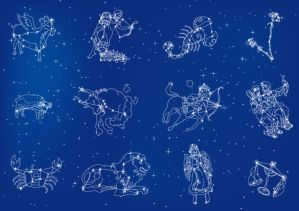
The zodiac is a series of constellations that rotate in the night sky. The sun passes through each of them in turn. There are twelve zodiacal constellations: Aries, Taurus, Gemini, Cancer, Leo, Virgo, Libra, Scorpio, Sagittarius, Capricorn, Aquarius, Pisces. They are also known as the zodiac belt, which means “circle of life”. The Sun also passes through the thirteenth constellation, the Serpent. However, according to ancient tradition, it is not included in the zodiac belt. The name of each zodiacal constellation originates from ancient legends, and each constellation is associated with many beautiful myths.
Each zodiacal constellation is occupied by the Sun for approximately one month. Interestingly, during the time that the Sun enters a zodiacal constellation, that particular constellation remains invisible from Earth. Only its neighboring constellations can be observed. Traditionally, the sequence of zodiacal animals begins with Aries, followed by Taurus, which astronomers believe to be the oldest constellation. On the other hand, Libra, the youngest constellation of the zodiac, was identified by scientists at a later time compared to the others. It is not easily discernible in the night sky. Similarly, the constellation Cancer is rather unremarkable. However, Aries is easily visible as it shines very brightly. Sagittarius, being the lowest zodiac sign, is situated closer to Earth than the other zodiacal constellations. The constellations Scorpio and Sagittarius can only be seen in the southern regions of our country. Nevertheless, all the other zodiacal constellations are visible throughout Russia.
Aries
Aries is the first astrological sign in the zodiac, symbolized by the Ram. People born under this sign are known for their courage, determination, and leadership qualities. They are often seen as confident and assertive individuals who are not afraid to take risks. Aries individuals are natural-born leaders and are always looking for new challenges and opportunities. They have a strong desire to succeed and are willing to put in the hard work to achieve their goals. Aries is a fire sign, which means they are passionate, energetic, and enthusiastic. They are known for their high energy levels and can be quite competitive. Aries individuals are also known for their independence and strong will. They are not afraid to speak their mind and are not easily influenced by others. Despite their strong personalities, Aries individuals are also known for their caring and protective nature. They are fiercely loyal to their loved ones and will do anything to protect and support them. Overall, Aries individuals are dynamic and ambitious individuals who are always ready to take on new challenges and make a mark in the world.
Aries, the initial zodiacal constellation, serves as the starting point for tracking the Sun’s annual movement. It typically enters the constellation Aries on April 18th, a time when many ancient civilizations celebrated the New Year. Our ancestors chose to symbolize this constellation with a ram, a creature that provided them with essential resources such as wool, meat, and sheep’s milk for cheese. The ram held a revered status, even appearing in depictions of gods with a ram’s head. However, the constellation is specifically named after a special ram known as the “golden fleece,” due to its exceptional golden wool. According to legend, the gods sent this ram to aid a young man named Frixus, who sought to escape his wicked stepmother. The ram carried Frixus on its back, ensuring his safety from pursuers, but was ultimately sacrificed to honor the gods who had sent him. This act was a common ancient custom. The skin of the golden fleece was later hung on an oak tree within a sacred grove, only to be stolen by Greek navigators, the Argonauts. To this day, the celestial Aries serves as a reminder of selflessness and the willingness to lend a helping hand whenever needed.
The Aries constellation is relatively small in size. It contains a total of 82 stars, although only 50 of them can be observed from Earth. These stars are not particularly bright and can only be seen in clear weather conditions. The majority of celestial objects within this constellation can only be distinguished using powerful telescopes.
However, there are three main stars in Aries – Gamal, Sheratan, and Mezartim – that are quite easy to spot in the night sky, especially during the autumn and early winter. These stars form a triangle shape that resembles the horns of a ram, as recognized by ancient astronomers. In fact, Aries was often depicted as a ram facing west with its head turned towards the east, as if looking back to see if it was being pursued.
Gamal, the brightest star in Aries, is known as the “grown lamb” in Arabic. For centuries, this guiding star has helped caravans in the desert and ships in the oceans stay on course.
Taurus
In ancient times, the constellation Taurus held great significance. The bull was considered a sacred animal in many cultures, so it’s no surprise that the first constellation named in the sky was in its honor. The ancient Greeks even believed that Taurus was Zeus himself, the supreme god, who transformed into a white bull to abduct the beautiful Europa.
Taurus is widely recognized as one of the most brilliant constellations in the night sky. Standing out among its stars is the radiant Aldebaran, a vibrant red star that surpasses our Sun in size by a staggering 36 times. Aldebaran is situated at a considerable distance from our solar system, requiring a lengthy 70-year journey for light to traverse the vast expanse and reach Earth. Surrounding Aldebaran, an impressive collection of 200 stars forms what is known as the Hyades star cluster.
An additional star cluster within the Taurus constellation is the Pleiades. According to ancient mythology, these celestial bodies are believed to represent the seven daughters of the titan Atlantean, who were transformed into stars by the mighty Zeus. The Pleiades cluster is one of our closest neighbors in the cosmos, easily visible to the naked eye for those who gaze upon the heavens. Those with exceptional eyesight can discern up to six or seven stars within the cluster, signifying good visual acuity. Those blessed with even keener vision may catch sight of ten stars, while the keen eyes of scientists utilizing telescopic instruments have detected several hundred stars within this captivating cosmic gathering.
Within the Taurus constellation, precipitation occasionally occurs. However, this is not your typical rain, but rather a cosmic, meteoric downpour. From late October to December, a spectacular meteor shower, resembling a celestial rainstorm, traverses this constellation.
More recently, astronomers have observed a nebula located within the Taurus constellation. It has been dubbed the Crab Nebula due to its resemblance to a crab in shape. A nebula is an immense cosmic cloud comprised of dust and gas. In terms of cosmic age, the nebula within the Taurus constellation is quite youthful, having formed less than a millennium ago. Historical records from Arab and Chinese astronomers confirm that on July 4, 1054, a supernova explosion of great magnitude occurred, with gases still dispersing in all directions at a staggering speed of 1000 km per second. This explosion was visible even from Earth.
Gemini
During a cloudless evening in the Gemini constellation, it is possible to observe as many as 70 stars. However, the most prominent stars in this constellation are Castor and Pollux. No other constellation contains two stars positioned as closely to each other as these two. Despite Castor’s fainter white-green radiance in comparison to the orange glow of Pollux, it is still regarded as the primary star of Gemini. On the other hand, Pollux serves as a guiding star, traditionally used to navigate travelers.
Within the constellation Gemini, there are numerous captivating celestial views. One such example is the Eskimo Nebula, which bears a striking resemblance to the head of a hooded man. It is sometimes even referred to as the Clown Nebula. Additionally, the Medusa Nebula closely resembles a diminutive jellyfish gracefully drifting through the vastness of the sea.
It was within the boundaries of the Gemini constellation that the planet Uranus was first discovered in the year 1781. Furthermore, in 1930, Pluto was also discovered in this constellation and remained classified as a planet within our solar system for a considerable period.
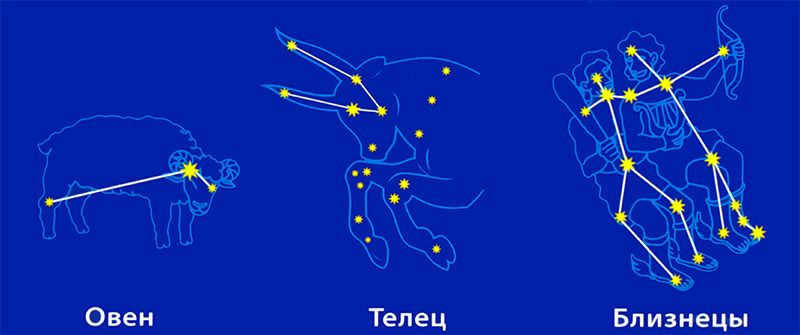
Cancer
Cancer is a relatively large, yet inconspicuous constellation within the zodiac belt. The stars in Cancer are not very bright, making them hard to see, especially in urban areas. The best time to observe Cancer is from January to May, when it rises high above the horizon. During other months, it can be easily overlooked due to its proximity to neighboring constellations Leo and Gemini. Around 2,000 years ago, Cancer marked the position of the summer solstice, which signified the longest day of the year. Prior to this day, the sun’s position at noon would gradually rise higher in the sky, but after the solstice, it would begin to “crawl” back down, resembling the movement of a crab. This marked the decrease in daylight hours.
Akubens, which means “claw” in Arabic, takes the main stage in the Cancer constellation. However, when it comes to brightness, it ranks third among the stars in this constellation.
Cancer, just like many other mythical creatures, made its way into the celestial heavens thanks to Hercules. According to the legend, during Hercules’ battle with the Lernaean Hydra (which also has its own constellation), all the animals stood by Hercules except for a massive Crayfish named Karkin. Karkin emerged from his swamp and dared to bite Hercules’ leg, for which he was swiftly crushed. As a token of gratitude, the goddess Hera, who despised Heracles, placed Cancer among the stars in the night sky.
Within the Cancer constellation, there resides a manger that is accompanied by donkeys. The manger is an exquisite star cluster, appearing to be a hazy speck when observed from Earth. The renowned scientist Galileo Galilei observed this peculiar and somewhat indistinct celestial entity, recognizing it as a tightly packed group of stars. Positioned amidst two stars known as Donkey North and Donkey South, the ancient Greeks firmly believed that these donkeys were placed in the starry expanse by the god Dionysus. These sacred animals were immortalized in this manner by the deity. The manger contains approximately 350 stars.
In the year 1996, a substantial planet was discovered within the Cancer constellation, followed by the discovery of two additional planets in 2002. However, due to the absence of advanced telescopes, scientists have been unable to thoroughly investigate these planets.
Leo
This constellation has been recognized for thousands of years. The brightest stars in this constellation form a non-uniform hexagon. Ancient astronomers identified the shape as that of a predator. Up to 70 stars from this constellation can be observed from Earth. Its name is a tribute to the first heroic act of the mythical figure Hercules. He conquered the fearsome Nemean lion that terrorized the people of Nemea, earning him the nickname. The lion’s skin was impenetrable to arrows. Hercules strangled the fearsome creature and then wore its skin as protection against arrows. In honor of this event, the Nemean Games were established, serving as a precursor to the Olympic Games. It was during this time that the Leo constellation appeared in the night sky.
Arcturus, a highly luminous star, is located in the Leo constellation and is ranked as the sixth brightest celestial body in the night sky. Its significance was recognized in 1635 when astronomers observed it through a telescope during daylight hours, marking a significant accomplishment during that era.
Leo, as a constellation, holds great importance and serves as a pivotal guide for astronomers in locating various other constellations within the spring sky.
Within the Leo constellation, a meteor shower known as the Leonid occurs every 33 years in mid-November. This phenomenon was initially observed by scientists in 1799, where they witnessed approximately 30 thousand meteors. Today, astronomers have recorded up to 150 thousand of these celestial bodies, swiftly traversing through the Leo constellation.
Virgo
Virgo is the biggest constellation in the zodiac belt and the Northern Hemisphere. Among all the constellations in the night sky, Virgo is the second largest, only surpassed by Hydra, which is a constellation in the southern sky. The Sun enters the constellation of Virgo on September 16th and remains there for a period of 44 days. In comparison, the Sun doesn’t spend more than 25 days in any other constellation.
The formation of stars in this constellation creates an irregular pentagon shape. However, in ancient times, people perceived it as a depiction of a youthful woman grasping a bundle of grain. Consequently, the primary star within the constellation is named Spica, derived from the word “ear”. Spica, a bluish-white star, emits an exceptionally luminous glow. Its brilliance is equivalent to the combined radiance of 600 suns. Spica can be observed from any location except for the North Pole. Another prominent star in this constellation is known as Vindemeatrix, which translates to “winemaker”. The Greeks and Romans recognized the rise of this star as an indicator to commence grape harvesting.
However, the Virgin was frequently regarded as the goddess of justice, known as Astrea. In the beliefs of the ancient Greeks, she was the final deity to reside on Earth. Astrea would weigh the good and bad actions of individuals on a scale. Unfortunately, it was revealed one day that people were committing more bad deeds. Astrea, feeling disheartened, discarded the scales in despair. They eventually came to rest in the vast expanse of the starry sky. And there they remain, right beside us, forming a neighboring constellation.
The Virgo constellation houses the nearest galaxy cluster to our own. Astronomers have cataloged 2500 “starry islands” within this cluster, some of which bear a striking resemblance to our own Milky Way. Rather than being given names, scientists have assigned them numerical designations, such as galaxy M84. However, a fortunate few have received unique names of their own. The Sombrero Galaxy, for instance, can be observed even with a basic school telescope. This spiral galaxy truly resembles a hat.
The most dominant quasar is located in the same constellation. This celestial body radiates an incredibly high amount of energy, estimated to be about 10 trillion times greater than that of our Sun.

Libra
Many centuries ago, over 2000 years in the past, the autumnal equinox marked a significant point in this particular constellation. It was during this time that the stars appeared to create a harmonious balance between the hours of daylight and darkness, which may explain the constellation’s name, Libra. Interestingly, despite being an inanimate object, the scales of Libra have also been the subject of various legends and myths. According to ancient Greek belief, it was on these very scales that the gods would weigh the deeds of individuals, determining whether they were good or bad.
Currently, astronomers have made an incredible finding in the constellation Libra, which has been named Gliese 581. It is classified as a red dwarf, which refers to small stars that are relatively cold. Gliese 581 is three times smaller than our Sun and significantly colder. This red dwarf is also home to four orbiting planets, which astronomers are closely monitoring. One of these planets potentially holds liquid water, raising the exciting possibility of life. After all, life necessitates heat, light, and water, all of which are present. As a precautionary measure, astronomers have even sent radio messages to Gliese 581.
In the vicinity of Libra, astronomers have made another remarkable discovery – the most remote star in our galaxy. This star, however, is not a red dwarf but a red giant, and it surpasses the Sun in size. Its distance from Earth is so immense that its light takes 400 thousand years to reach us!
Scorpius
The constellation Scorpio is only visited by the Sun for a brief period, unlike other constellations where it lingers for 20-25 days. After its short stay in Scorpio, the Sun moves on to the constellation Serpentine, which is not traditionally considered a zodiacal constellation.
Scorpius is a captivating and prominent constellation adorned with 17 dazzling stars. Its full splendor can only be observed in the southern regions of our country. The most brilliant star in Scorpius is known as Antares, which not only enhances the beauty of Scorpius but also adds to the enchantment of the entire celestial sky. Antares emits a radiant red glow and is 700 times larger in diameter and 9000 times brighter than the Sun. It comes as no surprise that travelers and sailors have relied on this star for navigation for centuries.
Scorpius is one of the few constellations whose shape truly embodies its name. With a little imagination, one can easily envision a colossal scorpion with its elongated pincers in the night sky.
Legend has it that the Scorpion made its way into the sky by stinging the mythical hunter Orion. Orion’s constellation is in close proximity. When the Scorpion appears in the sky, Orion disappears below the horizon, as if escaping from his attacker. And it’s not just Orion, the Sun itself is regularly “stung” by the harmful Scorpio: it enters this constellation in late autumn and begins to “fall ill” – this is how the ancients explained the arrival of winter.
Over 2 thousand years ago, in 134 BC, a new star erupted in Scorpius. The explosion was visible from Earth and was recorded by ancient astronomers. As a result, a scientist named Hipparchus decided to rewrite all the visible stars in the sky. This marked the creation of Europe’s first star catalog.
Scorpius is home to numerous nebulae and star clusters, boasting a particularly stunning Beetle Nebula. At the heart of this nebula lies what is believed to be the hottest star in the entire universe. This star emits an extraordinary amount of brightness, yet it has remained elusive for many years, concealed within a dense cloud of ice and dust. However, the Hubble Space Telescope has recently captured a photograph of this elusive star.
Sagittarius, the southernmost constellation of the zodiac, is renowned for its exceptional brightness in the night sky. This constellation boasts numerous stars, but their radiance makes it challenging for scientists to explore this specific region of the celestial sphere.
In Greek mythology, Sagittarius is depicted as a centaur – a half-human, half-horse creature – and is regarded as a popular hero. In the night sky, Sagittarius aims its bow towards the neighboring constellation of Scorpio.
For astronomers, Sagittarius holds great significance. It harbors a multitude of globular clusters, as well as dark and light nebulae. Some of these celestial formations can even be observed using basic binoculars. Additionally, the Lagoon Nebula, a prominent nebula within Sagittarius, is visible to the naked eye when viewed from rural areas, far away from the overpowering city lights.
Scientists have determined that the center of our Galaxy, located in Sagittarius, is a vast collection of stars. This stellar cluster exerts gravitational forces on all the other stars in the galaxy, causing them to orbit around it. As a result, our Sun orbits around this cluster, and consequently, the Earth orbits around it as well. However, the center of the galaxy remains concealed from our view due to interstellar dust clouds. No one has ever been able to directly observe it.
Nevertheless, Sagittarius does reveal other intriguing celestial objects, such as a dwarf galaxy that exists within our own galaxy, the Milky Way.
The constellation Sagittarius is also home to the heaviest star in the entire Universe. Scientists have made an incredible discovery revealing that this star is a staggering 150 times more massive than our own Sun. In a mind-boggling display of power, this star can emit as much light in just 20 seconds as the Sun can emit in an entire year. This extraordinary star is known as Pistol, but not because it poses a threat to anyone. The nebula surrounding this record-breaking star takes on the shape of a gun, which is why astronomers have aptly named it Pistol. It is worth noting that nebulae often have peculiar and unique shapes, adding to the wonder and mystery of the Universe. Furthermore, it is within the constellation Sagittarius that we find the most breathtaking and awe-inspiring section of the Milky Way. At least, that is the consensus among astronomers who have marveled at its beauty.
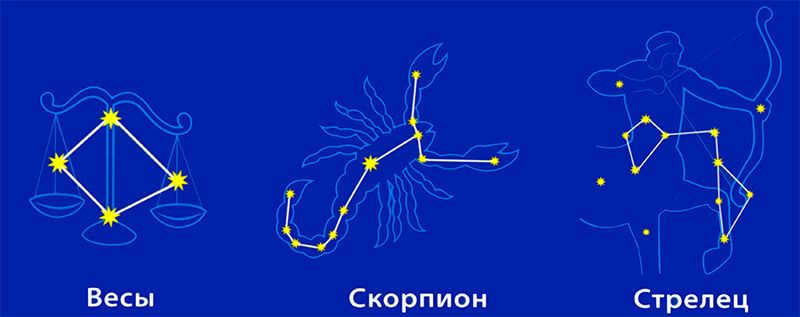
The sign of Capricorn
Capricorn is a constellation located in the southern sky that is known for its modest appearance. It features a limited number of bright stars that never rise high above the horizon. The best time to observe Capricorn is during the months of August and September. The stars in this constellation are arranged in the shape of an elongated triangle, which pilots often describe as a smile in the sky. However, modern astronomers suggest that Capricorn more closely resembles an inverted hat, while ancient astrologers saw it as a representation of a mysterious creature – a goat with a fish tail. According to legend, this Capricorn was a loyal servant to the mighty Greek god Zeus, who rewarded him by placing him in the heavens. In Russia during the time of Peter the Great, this constellation was referred to as the Goat or the Goatwoman. Interestingly, Australian Aborigines saw the same stars as the outline of a kangaroo. Capricorn can be considered a guiding constellation, as African tribes in the Kalahari Desert still use it for navigation.
When astronomers observed this constellation, they made a groundbreaking discovery in 1846 – the planet Neptune. But even before that, in 1764, a globular cluster was found within this constellation. A globular cluster is a compact group of stars located in a small area of the sky. Typically, these clusters are identified by numbers rather than names, and this particular one is known as MZO. It was first spotted by the renowned French astronomer Charles Messier, who is famous for his comprehensive catalog of stars that scientists still rely on today. More recently, the Hubble Space Telescope captured images of three previously unknown galaxies in the Capricorn constellation. These galaxies are yet to be thoroughly studied and examined.
Aquarius
Aquarius is one of the largest constellations in the zodiac. Its name derives from the myth of Ganymede, the young Trojan who was taken to Olympus by the gods due to his extraordinary beauty. The constellation is characterized by the presence of seven prominent stars that form an arc resembling water flowing out of a large vessel. Additionally, there are five stars that outline the shape of a jug, from which this “water” seems to be pouring out. Ancient astronomers interpreted these stars as representing a young man holding a jug.
The symbolism of “cosmic water” in Aquarius is closely connected to earthly water. In the past, the appearance of Aquarius in the sky coincided with the rise of water levels in the Nile River, as if the constellation’s figure was pouring water from his vessel into the river. For the ancient Sumerians, the presence of Aquarius in the night sky marked the beginning of the rainy season.
In the Aquarius constellation, a star that resembles our Sun is in the process of its gradual demise. Currently, it has progressed to the stage of being a planetary nebula, a fate that awaits all stars. In approximately 5 billion years, our very own Sun will undergo this transformation into a nebula. Among the countless nebulae in the night sky, the one in Aquarius stands out as the most brilliant and expansive. This particular nebula is illuminated by the most scorching stars recognized by astronomers. Typically, these stars occupy the center of nebulae, however, the one in Aquarius possesses the highest recorded temperature.
There is another celestial object in this group of stars that is made up of four bodies that are attracted to each other. Another fascinating aspect of this part of the night sky is a bright globular cluster that surpasses all others in terms of the number of stars it contains. However, it is located too far away for us to see it properly from Earth. Aquarius is also the home of one of the stars that is closest to our own, a red dwarf that could be reached in 15 years if we were traveling at the speed of light. Recently, scientists have discovered that there are three planets orbiting this star that are outside of our own solar system. These planets are known as exoplanets. Despite the fact that modern technology allows us to discover more and more of these planets, we still have a limited understanding of them.
Pisces
The constellation Pisces covers a vast expanse of the night sky. It is home to numerous stars, although only around 70 of them are visible to the naked eye and even then, they are not particularly bright.
The primary stars that can be seen from Earth form an acute angle, with the star Alrisha positioned at the apex. In Arabic, Alrisha translates to “rope” or “string,” which is fitting as ancient maps depicted this constellation as two fish bound together by a string. While not the brightest star in Pisces, Alrisha holds significance as the central star. From Alrisha, two lines of stars diverge, one heading north and the other extending westward. These lines represent the fish associated with Pisces – the North Fish and the West Fish.
The constellation that has been known for ages is Pisces. In ancient Greek mythology, it was believed that this constellation represented not only fish, but also the goddess Aphrodite and her son. According to the myth, the fearsome monster Typhon once attacked Olympus, the home of the gods, and they all fled in fear. In a desperate attempt to escape, Aphrodite and her son transformed themselves into fish and plunged into the sea. This incredible event became a legendary tale and the two giant fish remained in the celestial ocean as a symbol of it. However, it is more likely that this myth originated after the constellation was named Pisces. The reason for this is that when Pisces appears in the sky, heavy rain often follows in many countries, just as it did in ancient Greece. In other cultures, the Sun enters the Pisces constellation at the start of the bountiful fishing season.

